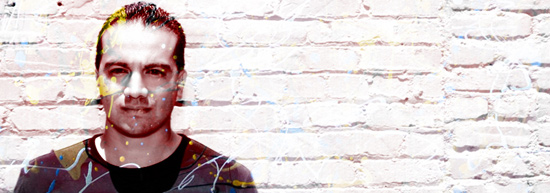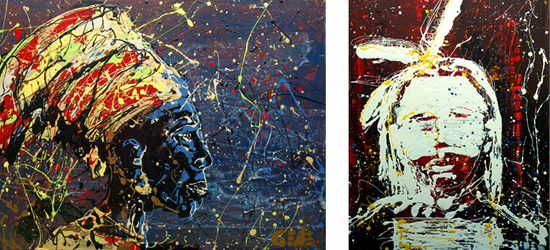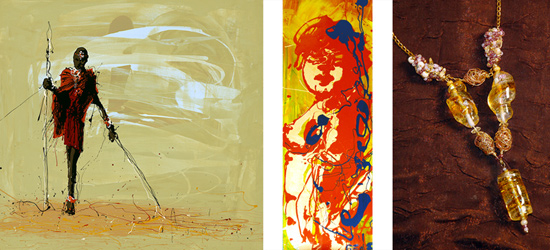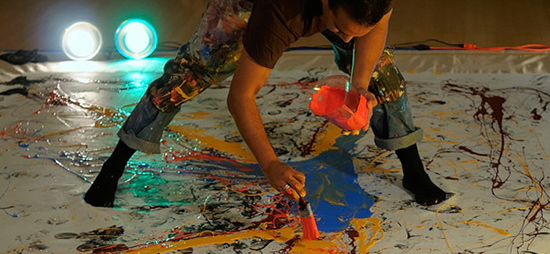Brand Interview – Gene Jimenez, Artist and Founder, 24 Peaces
Brand Interview – Gene Jimenez, Artist and Founder, 24 Peaces
How long has your company been in business? Please tell us a bit about your company, its mission, goals…
I have been a graphic designer for close to 20 years. However, I have only been a professional artist for the last ten years. By professional artist I mean a painter who shows in galleries. I have worked as a graphic designer in comic books, fashion, magazines and the web. My paintings have been in galleries from Los Angeles to New York. It is my paintings that I really center all of my work around, although I am still a graphic designer.
The primary focus of my work is to create a style of art and lifestyle around my art that is energetic and soulful in nature. I paint, glass-blow, make jewelry, sculpt and work in multiple mediums, such as recycled materials. My art originates from the single energy that we are and are all a part of. All I really do is channel that energy to the paint that then goes on to the canvas. The thought is that regardless of the medium, by drawing from the energy that ‘is’, or the existing energy of humanity and the world at large, art and beautiful creations are inherently the result of us as beings. Some may be scratching their head and saying, “What is he talking about?” To simplify, if I can, I create with the same energy that you feel when you are in love, when you experience happiness or even when you cry with joy. I access that energy and turn it into my art.
Do you donate to charities? Tell us about that also and why.
Yes. I have my own non-profit project called 24 Peaces (24peaces.org). It’s an artist’s journey to inspire people to create peace through exploring its meaning with twenty-four peacemakers from around the world. I am conducting a series of twenty-four conversations with both preeminent peacemakers and a cross section of “every-day people,” from diverse backgrounds and cultures. I feel that we all have a different personal definition of what ‘peace’ really means, since we have yet to get near a common definition as a global community. From those conversations I am creating twenty-four paintings based on the energy and content I experience. The end result will be a traveling documentary film and art exhibition. We are aiming to have the world premier in 2013 at a United Nations conference, but I can’t say much more about that until we are officially confirmed. It has been quite a journey so far. My favorite part is that all proceeds from the traveling exhibit and movie will be distributed back to the various 24 peacemakers global charities and organizations. That’s 24 charities with one project!
I never wanted to run a non-profit, but I do feel that art is a critical voice in the world that is silenced more and more everyday. I consider myself a ‘creative-activist’, or someone who uses their art to affect positive change. This term comes from the Creative Visions Foundations (creativevisions.org), of which I am closely associated with and who actively support creative projects like ’24 Peaces’ garner support. I feel artists are the key to mankind’s future as a species. Likewise, I feel even stronger that we are all artists, from birth. We just need to keep allowing ourselves to be creatives vs. doing what others want us to do in the world.
How did you know what typeface (font) would be right for your company wordmark or logo?
I have always been a huge fan of the right type and I love typography as an art. My logo is a combination of a couple elements. First, is the ‘insignia’, which consists of two koi swirling around a universal peace symbol. The style is reminiscent of Native Indian, Celtic, and Aztec markings. While my heritage is primarily hispanic, I feel a deep connection to all native tribes as they seem to be most connected with humanity. The lettering in the logo is actually a signature from one of my paintings that I scanned and both are stylized to be cohesive. Most all other typography I use is generally a standard, communication oriented type, which is normally Helvetica. There are some people who will know Helvetica and admonish its’ over-use, but it has become a universal style of clear communication. That is what I want to communicate: Clarity in message and clarity in humanity.
Did you design your own identity and web presence? Also, tell us more about the illustration ‘insignia’ and how that developed?
I designed it myself, with the help of some unexpected people. The ‘GENE’ letters, like I mentioned, are from a painting signature that I use. I have had those for some time now and have always felt something was missing. Currently, I am about to open a studio/gallery where people can come see me work and buy my art in the gallery. This is VERY exciting for me. With the creation of this new venture, I needed to create an extended brand ID. Just ‘GENE’ is fine for my signature on paintings, but that wouldn’t work as a gallery name. My new studio/gallery will be called “Sanctuary Creative Arts.” With the new name, I wanted to develop an icon that acts as it’s own sort of totem, or spiritual symbol. I told my 10 year old son I wanted to design a new logo and include the peace symbol and maybe a koi fish, since that is one of my other passions, raising koi fish. The next morning he came to me with a drawing of 2 koi fish swimming around a peace symbol. It was perfect! I then found the style of art I wanted on an artist blog and paid that artist to use her stylized koi. I altered the position of the fish from the original art and added various markings to develop the official insignia for the brand. For my personal art, I incorporated the insignia as wax seal, reminiscent of old world artisans. Now I have a multifunctional symbol that can be used in a number of branding duties. The insignia is used in all my branding now and will be incorporated in all studio/gallery operations.
How did you decide on the right color palette to fit your company look and feel?
I use all colors! Probably a little too much for some people’s taste. Red is the primary color because it is also a color that evokes a primal reaction. I want to speak to the raw person within people. If I create something for someone to experience themselves in a deep human level, then I think I have done my job. That experience starts with the logo. I will say mine is complex, but I also think that the red anchors it in primal instincts for people.
In what order did you present your company to the world? Did you start with marketing and products, or website, blog and social media?
I actually started in a small gallery in an artist village in downtown Santa Ana, California. I was terrified at my first showing. I had never shown any paintings, ever! I sold a painting the first night and within 3 weeks I had sold 3 more. I stayed at that gallery for the next 3 years and am forever grateful to my fellow artists friends I made there. I learned a lot about what to do, and what not to do. Marketing and subsequent product announcements have primarily been via social media. Facebook and my personal website are the two main points of contact for me. I think I am lucky though. I am a graphic designer with a Masters Degree in Media Design, so I design all my media myself. That is great because I don’t have to pay anyone to do it. The downside is I have to do it. It does take time, and now that social media has become the primary source of marketing in the world, it requires more time than ever. I use Twitter, but haven’t found success with it. I admit, I’d rather have a conversation with a real person. My art is meant to be experienced in person, at a soulful level. I have yet to talk to someone who said they got that from electronic media. Maybe that is good feedback for my online design? Ha! Even though I have been doing design for close to 20 years, there is always more to learn how to communicate.
How long after the launch of your company did you start pitching in social media?
It was immediate. Like I said, I was and still am, a professional graphic designer. I already had a website that was geared towards my graphic design. When I started painting, I just posted those on the site as well, and then started sharing them via social media. I don’t really think I was even conscious that I was ‘marketing’ at the time. I just wanted to share my work.
Did you do research or study any software, take webinars, teleclasses, before approaching any area of your marketing or web presence?
No. Ha! There weren’t any. What I knew came from my professional experience as a web designer and creative director for online companies. I really don’t remember telling any of those companies I was a web designer. They just liked my imagination and hired me. I had to figure out what Flash, html, and Java was all by myself. Before I knew it, I was directing online flash music videos, designing corporate web hubs and branding television shows online. In my opinion, decent marketing starts with solid design fundamentals. I don’t think my design is revolutionary, but I do feel my fundamentals are good enough to execute semi-successful campaigns. People still hire me for a wide range of online and traditional design projects related to marketing their projects, so I think I’m doing something right.
Do you advertise locally in newspapers and/or nationally in magazines? Are they effective?
No. Not because I don’t want to. I just don’t have the money or haven’t focused on that end of the industry yet. With the development of Sanctuary Creative Arts, I will be doing local print and trade advertising. Here in Southern California, and with most art destinations I visit, there are printed directories, guides and catalogs of local artists. I think it is important to establish one’s self locally, and then proceed to a global audience. I always find it odd when someone from another state or country says that they know a ‘world famous’ person from my hometown. Really? How come that person’s hometown doesn’t know them? Likewise, I think it’s supportive if you bring not only yourself, but your ‘village’ with you in your successes. In other words, have respect for the shoulders you stand on.
Do you advertise online using Google, Facebook or on other company sites? Are they effective?
I think they are effective and they aren’t effective. I say this from the previous example I give. I see a lot of great people doing great things online. I would also suggest that there are a ton of people online that are just online to make quick money and leave the consumer and patron with nothing. The effective campaigns not only provide a quality product, but they also provide a relationship with the consumer. I have a lot of ‘friends’ on Facebook. All of whom I am grateful for ‘friending’ me. However, I can’t say that I have a relationship with all of them beyond that. Would I like to? Yes. Can I? No. So then why do I have them as ‘friends’? My own philosophy is to share with them what I am up to in my life. For me, that is art and many of my ‘friends’ know that and chose to know me online because of that. I choose people online in the same manner. Personally, I pay attention to about 10% of the ads that I see online, and I don’t think I am different than anyone else using the web. If it is creative, interesting and relevant to my life, I will investigate.
When you printed your products, packaging, business cards and other print marketing did you choose an online printer or visit a local vendor?
As a graphic designer, I try to use local printers, but sometimes costs prohibit that, so I use online printers too. Both are good choices. For my new company, I already know I will be using an online printer because I like the quality and know exactly the product I am going to get. For that same quality, I would pay more locally. This really does come down to experience. Sometimes, you will get what you want, and other times you won’t. The key to working with vendors online, or even in person is to be in ‘learning mode’, or be willing and open to alternative outcomes. Whatever happens, learn from it and make it a criteria for future decisions. I have had many successes in taking a leap of faith with a vendor and also had some disasters, but I learned from both.
Did you know anything about different types of papers, when you wanted to print your marketing materials?
Yes. This comes from my graphic design career. I was fortunate enough to learn design before computers, thus, paper types were a core part of the curriculum. I am a professor of design now (at the University of Redlands) and teach paper stock to my students. It definitely helps to know what the printers are talking about when they say text or cover stock, uv gloss or matte finish and binding, etc… Paper activates another sensory, touch, that can be effectively used in a marketing. The more senses you activate with people, the more likely they will comprehend and remember your message.
Have you ever used “green” technology in printing, using FSC certified papers or recycled paper and if not, how likely are you at trying this on a next project?
I have used recycled and FSC paper, though not as often as I would like. Both have their pros and cons, depending on who you talk to. I think the FSC papers have the broader range of paper types and finishes, whereas there seems to be a lane that recycled papers are in that doesn’t allow for a huge diversity. It does come down to three criteria: 1) How much does it matter that either are used, 2) Does your budget allow for either, and 3) Does your target audience know or care about the difference? I have no real opinions either way. I have yet to hear arguments that bolster the positions of these types of papers and the process by which they are made vs. traditional methods, other than the FSC papers, in my mind, seem the most logical. We will have to wait another 20 years to see if it is actually working though. I use unused house paint on my paintings and try to find odd or discarded canvas and materials to paint on. I think anything we can consciously do to support the planet we live on, is never a bad thing.
If you sell products, are they produced in the USA or abroad?
Everything I produce is made in the USA as of now. I am not opposed to producing outside the U.S., but if I can make the same thing here for the right amount that allows me to make a living, I will produce it here.
Is there anything you haven’t yet tackled, but will want to do soon?
That’s a good question. I am striving to have my mind more in what is going on right now, but I will try to answer.
In establishing the new studio/gallery, I would like to affect the way the U.S. addresses the arts here at home, along with many other issues. I feel, and this is just me, that U.S. citizens get enamored by the labels that the world or their egos have created in being able to say that they personally support people on the other side of the world. I constantly see advertisements and solicitations to buy art from another country so that people in other country’s can eat or make a living. My wife and I have a rule: if we physically visit the town or country, then we will buy from an artist from that town or country. I am barraged with people asking me to contribute to auctions that will support a remote village in some other country. I am good with that, however, more and more, the people asking and behind it seems to be more about what their image is over the real causes. Unless someone is willing to go another country and do some real feet on the ground work, I hesitate in believing some people motives. You want to make a difference? Make a difference to your neighbor. Make a difference to your artist ‘friend’ who is trying to feed his family and make a living. Make a difference to the homeless people in every city in the U.S. Make a difference to the indigenous people of North America who never recovered from the genocide that they went through that established the U.S. as it is today.
What many Westerners, who pay little attention to, or are in fact seeking to eliminate the arts in schools, fail to realize is that the arts is what defines a culture. What do you think fills up museums? When they look back 300 years from now, what do you think they will be looking at? The traffic reports from your website? No. They’ll be looking at the art from this era. What did that culture cultivate? What kind of man were they that inspired the art that was left behind? What were they passionate about? When we look to eliminate culture in our own homes, we do little to cultivate it anywhere else. We are just making our egos feel better by make believing we are doing something, while what is around us is dying.
I want people to come see me work, in my studio and experience a part of themselves through my art, in person. I have a difficult time believing that writing a check, ‘like-ing’ a web page or clicking a PayPal button creates that experience. If it does, then what do I know. Maybe what I am looking to tackle is bringing mankind back to something it seems to have put on the back burner. Humanity.
24 Peaces from Ron Judkins on Vimeo.
To learn more about Gene Jimenez and 24Peaces, visit the links below:
Website:
studioGENE.com
24peaces.org
sanctuarycreativearts.net
Twitter:
creativegene
24Peaces
Facebook:
https://www.facebook.com/artistgene
https://www.facebook.com/pages/24-Peaces/85358144216
LinkedIn:
http://www.linkedin.com/in/genejimenez
- Communicating With Your Mind, Tone of Voice and Body Language
- The Public Shows It’s Power Against A Corporate Giant
One thought on “Brand Interview – Gene Jimenez, Artist and Founder, 24 Peaces”
Leave a Reply
You must be logged in to post a comment.






Congrats, Gene! Where, again is your new gallery / studio?